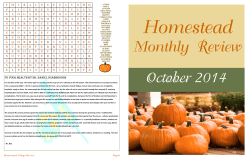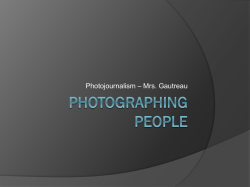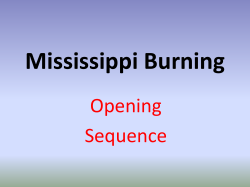
But were afraid to ASK!
But were afraid to ASK! Camera Angles and movements combine to create a sequence of images, just as words, word order and punctuation combine to make the meaning of a sentence. You need a straightforward set of key terms to describe them! When describing camera angles you have to think about three important factors: 1. FRAMING (or LENGTH) of the shot 2. The ANGLE of the shot 3. If there is any MOVEMENT involved Each different shot has a different purpose and effect. Changing between shots is called a CUT. WIDE ANGLE SHOT *Generally used as a scene-setting, establishing shot. *Also referred to as an EXTERIOR (outside of buildings, landscape, action as in massive war or disaster film) *Very little detail, meant to give general impression LONG SHOT *Generally shows image as “lifesize”. *Full shot of entire human body, with head near the top, feet or ankles near the bottom. *The focus is on the actors, but plenty of background appears in detail MEDIUM SHOT (Most commonly used shot.) • Approx shows figures from the waist up (with leeway). • Also know as a Two (or Three) Shot, based on number of people. • Great for dialogue and/or show some detail of action • A little background visible, that has already been established CLOSE UP • Almost no background visible • Concentrates on full face (shoulders can be present) • Objects would fully fill the screen • Magnifies the importance of face/object • Brings us into the mind of character, think: personal space issues. EXTREME CLOSE UP • Considered a SFX • A part of an object (eyes, mouth) filling up the screen • A small object (a quarter, a football) filling up the scene BIRD’S-EYE VIEW • Shows scene/shot from directly overhead • Sometimes making object unrecognizable • God-like view High Angle • Similar to but not as severe as Bird’s-Eye View • Camera is elevated and looks down on subjects • Makes subject seem smaller, less significant EYE LEVEL • A neutral shot • Approximates “normal” vision • Most common angle used LOW ANGLE • Camera is place BELOW normal use • Subjects appear bigger • Can be used to make audience feel inferior or confused • Background in Low Angle shots are often the sky or ceiling OBLIQUE/CANTED ANGLE • The camera is tilted • Suggests confusion, being unbalanced, or mental instability Instead of a series of CUTS (going from one shot to another) director’s often choose to move camera Makes the action seem slower Takes more time to watch, to set up to film PAN SHOT • The movement scans the scene horizontally • This pans or scans over the scene, like looking side to side TILT SHOT The movement scans the scene vertically This pans or scans the scene up & down DOLLY/TRACKING SHOT The camera moves ALONG the action or subject. The camera is either on free standing wheels or on a train-track like device BOOM or CRANE SHOT The camera moves vertically through space This can also include side to side through space (not on the ground). Zoom This changes the magnification of the subject This applies to both increasing size (Zoom IN) and decreasing size (Zoom OUT) Should be thought of as a sfx and used sparingly http://www.lavideofilmmaker.com/filmmaking/film- techniques.html
© Copyright 2025





















